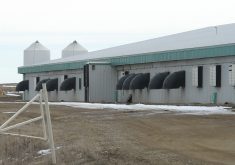Monsanto is making progress on its goal to double canola yields, says one of the company’s lead researchers.
Part of the company’s global commitment to sustainable agriculture is to help farmers double their corn, cotton, soybean and spring-seeded canola yields by 2030.
The commitment with canola is to achieve average yields of 62.3 bushels per acre by 2030, up from 26.5 bu. in 2000.
Monsanto says that will be achieved through conventional breeding, biotechnology and improved agronomic practices.
It is already making progress in the yield and stress trait development work it is conducting in conjunction with BASF.
Read Also

Phosphate prices to remain high
Phosphate prices are expected to remain elevated, according to Mosaic’s president.
“We don’t have dozens yet, but we do have a few lead genes in canola,” said Tom Ruff, Monsanto’s director of yield and stress traits, who was in Saskatoon recently to deliver a presentation to the 10th Agricultural Biotechnology International Conference.
An intrinsic yield gene is one of those traits, which Ruff described as a gene that wakes up a plant and gets it ready for the sun.
“We’ve been able to modify that process in some ways, and we’re seeing some positive yield benefits from doing that,” he said.
Work on the intrinsic yield gene is more developed in soybeans, where there has been considerable field testing of the trait. The gene wakes plants up at around 6 a.m. and forces them to use that early portion of the day more productively.
The trait has demonstrated consistent results in field tests conducted in six growing seasons – three in North America and three in South America.
Monsanto is applying to canola what it learned about the yield-enhancing technology in soybeans.
“We have tested it in canola and have seen some positive things,” Ruff said.
The creation of drought tolerant crops is another yield-boosting technology where Monsanto is making considerable headway. Its first generation of drought tolerant corn is on track for commercial release in the western United States in 2012.
Five drought tolerant corn hybrids field tested in 2009 delivered nine to 11 bu. per acre more than control varieties, despite limited drought pressure that year.
The company is conducting more than 200 tests across the U.S., including more than 100 in the target markets of Colorado, South Dakota, Kansas and Nebraska.
Data is unavailable for this year, but a visual inspection suggests results similar to those of 2009.
The trait is also showing promise in sub-Saharan Africa, where corn yields have been among the lowest in the world. Yield and test weights are up in lines containing the gene and so are the number of kernels per ear.
Monsanto is working on a second generation drought tolerance gene that is expected to have broader appeal. Ruff said the trait, which is expected to make crops more efficient water users, may be employed in canola.
The company is also exploring nutrient use efficiency traits in all of its crops to accomplish one of its other sustainability goals of reducing inputs by one-third per unit of output.















